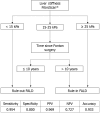Role of transient elastography in the diagnosis and prognosis of Fontan-associated liver disease
- PMID: 40124271
- PMCID: PMC11924006
- DOI: 10.3748/wjg.v31.i11.103178
Role of transient elastography in the diagnosis and prognosis of Fontan-associated liver disease
Abstract
Background: Fontan-associated liver disease (FALD) often occurs in patients with single-ventricle physiology following Fontan surgery, and ranges from liver congestion to cirrhosis. The assessment of the severity of FALD using noninvasive methods is challenging. However, transient elastography (TE) may be useful for the noninvasive evaluation of FALD and prediction of clinical outcomes.
Aim: To evaluate the role of TE in the diagnosis of FALD and its association with clinically relevant events.
Methods: This retrospective single-center study (Hospital Universitario La Paz, Madrid), including 91 post-Fontan patients aged > 18 years old. Laboratory and ultrasound findings, and liver stiffness measurements (LSM) by TE (FibroScan®) were assessed. FALD was defined using ultrasound criteria (hepatomegaly, liver surface nodularity, parenchymal heterogeneity, hyperechoic lesions, splenomegaly, collaterals) and advanced FALD was defined according to the European Association for the Study of the Liver-European Reference Network statement (esophageal varices, portosystemic shunts, ascites, splenomegaly). Clinically relevant events included heart or heart-liver transplantation indication, hepatocellular carcinoma, and all-cause mortality.
Results: Patient characteristics were: 60.4% male; Mean age, 33.3 ± 8.2 years; Mean elapsed time since surgery, 24.3 ± 7.7 years; 89% with FALD; 73% with advanced FALD. LSM by TE was associated with FALD [odds ratio (OR) = 1.34; 95% confidence interval (95%CI): 1.10-1.64; P = 0.003] and advanced FALD (OR = 1.10; 95%CI: 1.01-1.19; P = 0.023). Areas under the curve (AUC) were 0.905 and 0.764 for FALD and advanced FALD, respectively. FALD cut-off values comprised: Optimal, 20 kPa (sensitivity: 92.3%; specificity: 80.0%); Rule-out, 15 kPa (sensitivity: 96.9%); Rule-in, 25 kPa (specificity: 100%). A FALD algorithm was proposed based on LSM by TE and elapsed time since surgery (AUC: 0.877; sensitivity, 95.4%; specificity, 80.0%; positive predictive value, 96.9%; negative predictive value, 72.7%). LSM by TE was associated with clinically relevant events (OR = 1.07; 95%CI: 1.01-1.13; P = 0.021) and all-cause mortality (OR = 1.23; 95%CI: 1.02-1.47; P = 0.026).
Conclusion: In adult patients post-Fontan surgery, TE is a useful noninvasive method for FALD diagnosis. The association between LSM by TE and clinically relevant events suggests a role in prognosis.
Keywords: Congenital heart disease; Fontan; Fontan-associated liver disease; Liver stiffness; Single ventricle; Transient elastography.
©The Author(s) 2025. Published by Baishideng Publishing Group Inc. All rights reserved.
Conflict of interest statement
Conflict-of-interest statement: All authors declare that they have no conflict of interest.
Figures


References
-
- Téllez L, Rodríguez-Santiago E, Albillos A. Fontan-Associated Liver Disease: A Review. Ann Hepatol. 2018;17:192–204. - PubMed
MeSH terms
LinkOut - more resources
Full Text Sources
Medical

